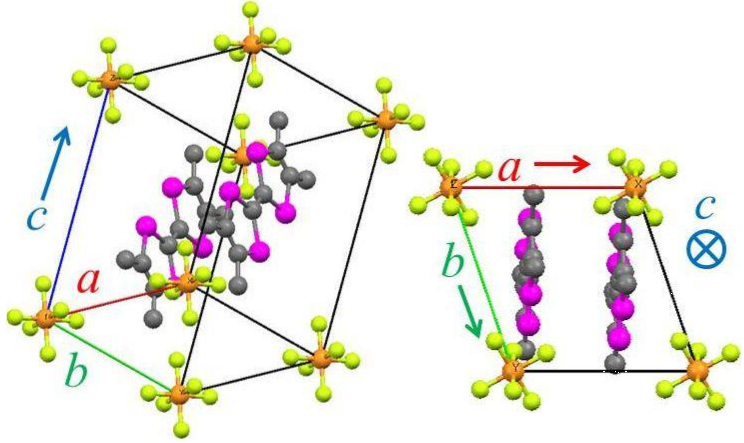Researches
Rich electron phase diagram for molecular conductors
In the field of condensed matter physics, researchers try to understand the diverse properties of electrons in solids taking advantage of quantum mechanics, and statistical mechanics. A key ingredient to unveil these properties is the many body effect, which is induced by the interactions among huge numbers of particles, such as electrons. In this context, we would like to manipulate the interaction and observe the variations in the properties solids caused by these modifications.
 The electron-electron interactions, however, are hardly manipulated,
as they are normally determined by materials
The peculiarity of molecular conductors, represented by the first organic superconductor (TMTSF)2PF6,
is that they give us a wide-range control on the electron-electron interaction
by means of chemical substitutions, and/or mechanical pressures.
The left picture shows that the low-temperature electron states are substantially modified by
the anion substitutions and also by the mechanical pressures of few GPa [1].
As a pressure of up to 2 GPa is experimentally accessible with a small pressure cell,
we are allowed to investigate the origin of electronic properties in solides.
The electron-electron interactions, however, are hardly manipulated,
as they are normally determined by materials
The peculiarity of molecular conductors, represented by the first organic superconductor (TMTSF)2PF6,
is that they give us a wide-range control on the electron-electron interaction
by means of chemical substitutions, and/or mechanical pressures.
The left picture shows that the low-temperature electron states are substantially modified by
the anion substitutions and also by the mechanical pressures of few GPa [1].
As a pressure of up to 2 GPa is experimentally accessible with a small pressure cell,
we are allowed to investigate the origin of electronic properties in solides.
13C NMR experiment on quasi 1-D conductor (TMTSF)2X
 The (TMTSF)2X salt, called Bechigaard salt after the discoverer,
is composed of monovalent anion X - and two TMTSF molecules.
The X anion introduces 0.5 holes par one molecule and
the injected holes are responsible for the conductivity.
The TMTSF molecules form a two dimensional conduction plane (ab plane), as shown in the right figure,
and the conduction planes are stacked along the c direction [2].
Within the ab plane, TMTSF molecules are stacked along the a direction,
giving rise to the highest conductivity along this direction.
This highly anisotropic conductivity is the reason why we call (TMTSF)2X and
its family compounds as quasi one dimensional conductors.
The (TMTSF)2X salt, called Bechigaard salt after the discoverer,
is composed of monovalent anion X - and two TMTSF molecules.
The X anion introduces 0.5 holes par one molecule and
the injected holes are responsible for the conductivity.
The TMTSF molecules form a two dimensional conduction plane (ab plane), as shown in the right figure,
and the conduction planes are stacked along the c direction [2].
Within the ab plane, TMTSF molecules are stacked along the a direction,
giving rise to the highest conductivity along this direction.
This highly anisotropic conductivity is the reason why we call (TMTSF)2X and
its family compounds as quasi one dimensional conductors.
We utilize NMR technique, which is one of the most suitable experimental method to explore the magnetic properties of electrons in extreme conditions, to investigate the many body effect in low dimensional conductors. With the NMR signal from 13C nuclear spins, we can obtain the static information, which will tell us the properties of magnetically or electrically ordered state, and also the dynamic information, such as magnetic fluctuations near the instability.
Magnetism and superconductivity found in the 1-D organic conductors remind us of the superconductivity near quantum critical point, which has been extensively studied in inorganic materials. In addition to the superconductivity near magnetic quantum critical point, superconductivity is observed near a charge ordered state in organic materials. A novel superconducting pairing mechanism would be revealed from our NMR experiments on organic conductors.
Reference
[1] D. Jerome, Science 252 1509 (1991).
[2] N. Thorup, G. Rindorf, H. Soling and K. Bechgaad, Acta. Cryst. B37, 1236 (1981).